SHARPENING
page index:
Sharpening - Axes and Mauls
Sharpening - Camber
Sharpening - Chisels
Sharpening - Drill Bits
Sharpening - Grit Comparisons
Sharpening - Grinder see woodworking#grinder
Sharpening - Honing Guides
Sharpening - Knives
Sharpening - Lapping
Sharpening - Lap-Sharp
Sharpening - Log of past sharpening
Sharpening - Makita
Sharpening - Misc
Sharpening - Odd & Irregular shapes
Sharpening - Oil to apply afterwards
Sharpening - Planes
Sharpening - Saws
Sharpening - Scissors
Sharpening - Scrapers and Scraper Planes
Sharpening - Tool Steels Compared
Sharpening - Tormek attachments
Sharpening - Turning Tools
Sharpening - Waterstones
Sharpening - Axes and Mauls
sticky: The_Forest_Service_Axe_Manual.pdf (local .pdf > 100mb so not added to github, search for "The_Forest_Service_Axe_Manual.pdf")
House Digest article
Complete_Guide_to_Sharpening_by_Leonard_Lee.pdf
pdfp 172 p167 for a maul
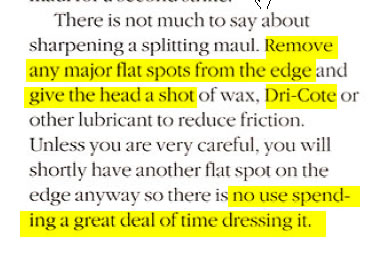
If it cannot be levered out of the cut, drive it through striking the head with one handed blow of sledge and other hand holding the handle to dampen vibration
NOTE: Bostik Dri-Cote has been renamed to BladeCote and that is what my can has on the label
pdfp 173 p168 for a splitting ax or maul

Sharpening - Camber
see also planes#camber
belt sander & grinders for creating camber on bevel up planes
detailed post on where I first saw Derek from Perth's solution using drawer handle
Derek using Tormek BG-100 tool rest on a grinder so can use Tormek attachments at lumberjocks post #8 more details here
post #7 has a nice home made angle jig for belt sander; this post has more info and another tool rest similar to Derek's
The Secret to Cambering Bevel Up Plane Blades
The Belt Sander Grinder - Mk I later printed in FWW 0190 Methods of Work pdfp20
The Belt Sander Grinder - Mk II
Don't Fear the Camber — DCW Woodworks
Camber
David Charlesworth "Learning Curves"
A cambered cutting edge is essential for fine finishing cuts with a hand plane – and it has many other surprising uses.
p53-59 August 2005 issue #149
David Charlesworth "Precision Hand Planing"
Use a curved blade in a handplane to make boards with truly flat faces and dead-straight edge
p54-59 October 2007 issue #164
How much camber should be in plane irons? at FineWoodworking
Camber Roller Assembly for Veritas Mk.II Honing Guide System at Lee Valley Tools
The secret to cambering Bevel Up plane blades
Don't Fear the Camber at DCW Woodworks
FWW 0222 pdfp28
Scrub Plane / Heavy Camber
article from Fine Woodworking Proven shop tips on regrinding angle at grinder with stick held in place by foot (local .jpg)
Sharpening the No 40 1/2 Scrub Plane video (or Roughing Blade with large camber for my No 4 & No 5)
FWW 209 pdfp 18 jig to heavily camber a scrub plane blade
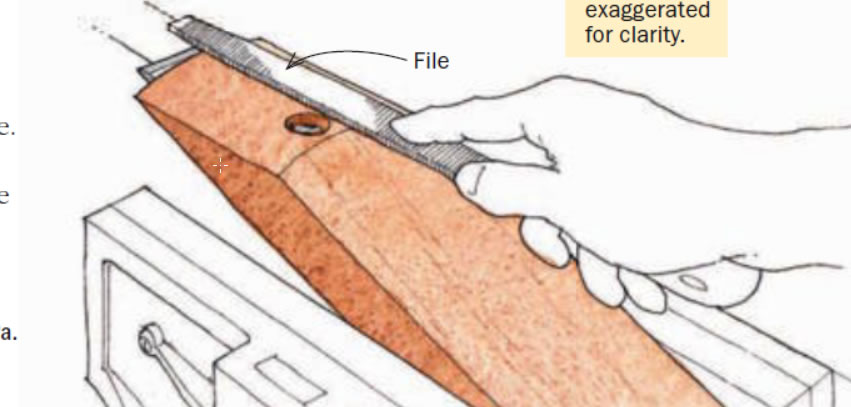
sharpening the extreme camber on a scrub plane FWW 0186 pdfp92
another article from wood mag 287 2023-03
post on additional techniques for the LN that is heavily cambered but also curved along the length but applies to others as well
post 5 uses a piece of pine he made profile with No 40 then put sandpaper on it and holding iron in vise uses curved pine to raise a burr that is then removed on a stone
post 7 uses same technique for many different gouges and blades
post 10 speaks of putting tape on the sole and filing but i don't want to do that
post 11 is about doing jigless by hand on a waterstone using figure 8 motion
post 13 lists the Lie-Nielsen instructions for sharpening it: either groove in softwood or make groove in old waterstone
post 16 holds blade in one hand and stone in other; outdoor sunlight is easiest to see
post 17 makes negative modl and uses diamond tape for hard to sharpen; for cambered plane blade just uses eclipse style
Sharpening Chisels
DO NOT USE THE RULER TRICK!
3 ways to determine if a chisel is sharp
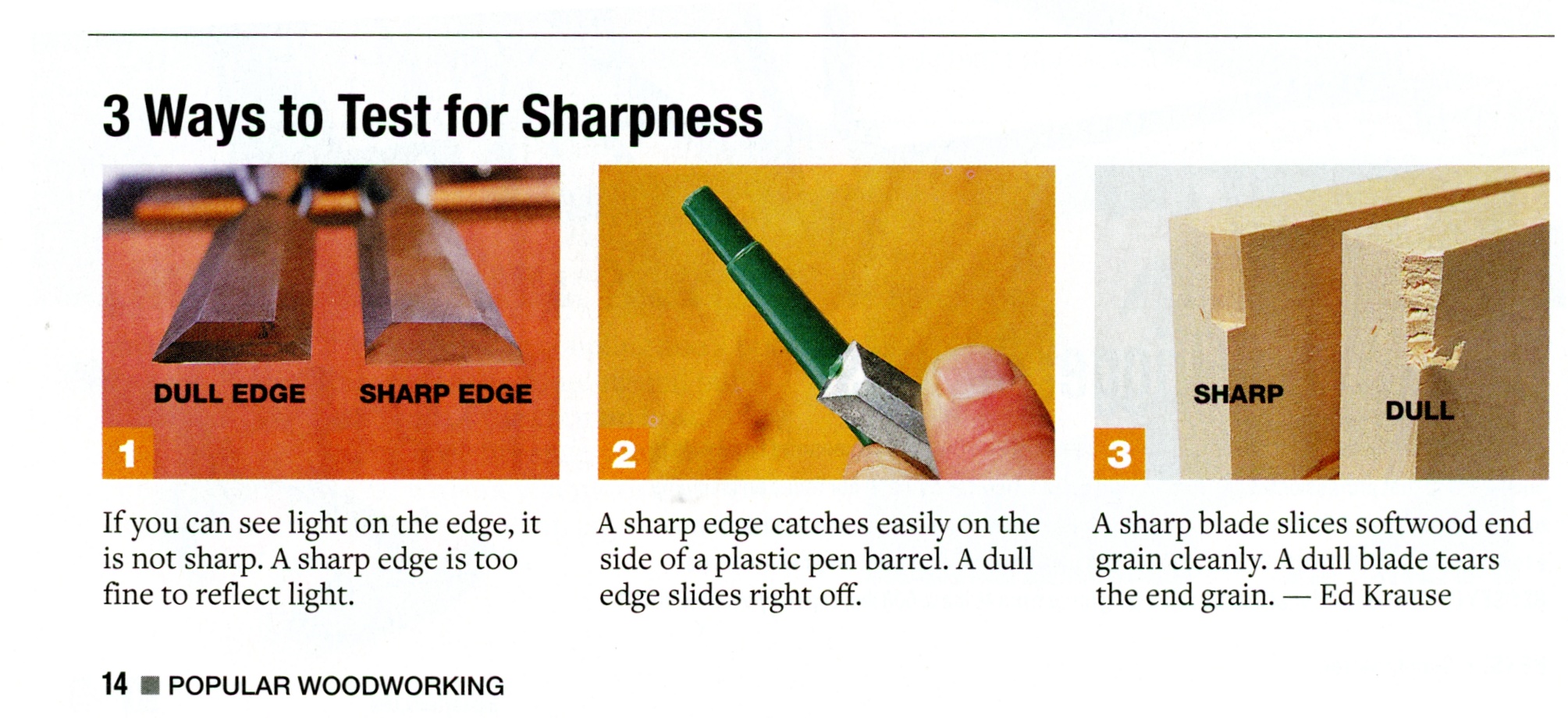
Lie-Nielsen Honing Guide video 6:10 for 1" chisel need Mortise Chisel Jaw Pair
Charlesworth Chisel Sharpening DVD notes
Deneb Puchalski youtube video on chisel sharpening
don't use ruler trick on chisels
13:58 regrind primary bevel with 220 & 400 on surface plate, may go down to 180 & even 80
Matt Estlea chisel sharpening video youtube
14:!0 he recommends 400 grit diamond or 400/240 grit waterstone for recreating primary bevel
Resurrecting Chisels PWW 2005-02 pdfp56 p74
Unicorn Method of Chisel Sharpening
inthewoodshop.com page on Unicorn Method
The Unicorn Sharpening Meathod| Popular Woodworking Magazine
Typical bevel angles for chisels (FWW 0181 pdfp47):
pairing chisel 15-20
bench chisel 20-30
mortise chisel 30-40
microbevel is typically 2-5
Sharpening - Drill Bits
sharpening drill bits
Sharpening - Grit Comparisons
Grit, Mesh, and Micron Conversion Chart from International Gem Society
Very detailed Gritomatic.com chart showing grit comparisons
sharpening grits comparison Chris Schwarz Popular Woodworking article, seach hdd for "GritComparisonChart2.pdf"
easy to read comparison
diamond paste substrates and polycrystalline better for tool honing than monocrystalline
"The Most Comprehensive Sharpening Test Ever Done" video where guy uses sharpness testing machine
Resurrecting Chisels PWW 2005-02 pdfp56 p74
waterstones: 4000 grit
and above are considered "finishing stones"; all non-finishing stones should be soaked for 10 minutes before use, it is OK to store them in water
Deneb Puchalski youtube video on chisel sharpening
don't use ruler trick on chisels
13:58 regrind primary bevel with 220 & 400 on surface plate, may go down to 180 & even 80
Matt Estlea chisel sharpening video youtube
14:!0 he recommends 400 grit diamond or 400/240 grit waterstone for recreating primary bevel
In Charlesworth's Chisel sharpening video
| brand |
coarse |
medim/fine (not used in plane sharpening) |
super fine |
| king |
800 |
1200 |
8000 |
| norton |
1000 |
4000 |
8000 |
Honing Guides
FWW 0184 p16 blade extension jig with v-groove for honing guide wheel
PWW Nov 2015 pdfp18 p16 Lie-Nielsen honing guide short review
Veritas
2023-01-14 Veritas MKII guide w camber roller review pww oct 2005 pdfp16 p32
near perfect only negative is the one can't put camber on an iron; apparently veritas didn't have the barrel shaped roller at the time
FWW 0198 June 2008 p22 camber roller guide released and fixes only negative p22
same article in
"2008 The Best of Fine Woodworking Handtool Skills.pdf"
pdfp12 with fewer pictures
instructions .pdf
Lie-Nielsen
Lie-Nielsen docs from here Sharpening instructions local .pdf
Lie-Nielsen Honing Guide video 6:10 for 1" chisel need Mortise Chisel Jaw Pair
Protrusion jigs
Lie-Nielsen Angle Setting jig local .pdf
honing extension jig with v-groove under wheel of honing guide Fine Woodworking 0184 pdfp16 p16
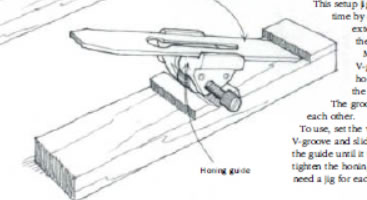
fww 0225 page 28 a honing guide is the great equalizer
Sharpening Knives
How To Sharpen A Serrated Knife
Knife Sharpening on a Whetstone
This instructables article on making a jig to hold the stone at an angle and the knife vertical seems easy to make and functional
I think making this jig to keep the knife horitzontal while the stone is angled seems a bit more complicated than necessary another
article suggests using pennies to establish correct angle
youtube video top 4 sharpening don'ts from Ethan Chlebowski
color edge with black sharpie, then review against this chart to determine correction needed
4-6 lbs hand sharpening a knife up to 8 lbs if it is really dull
start on medium grit 800-2000 grit [
if only 1 stone get 1000 grit]
use coarse grit < 800 if chips in edge or it was several years since last sharpening
fine grit 3000-6000 is polishing the edge
6:30 his basic technique
his full 31 minute sharpening technique youtube video
1:43 Shapon ceramics >= 1000 are "spash and go"
2:25 edge trailing is grinding away from the edge (like welding push vs pull)
apply sharpie marker before starting
7:00ish only pressure on edge trailing
9:30 for the other side he switches hands
12:48 after flipped burr by sharpening second side, do 5 stropping strokes in a row on each side to get rid of the burr
15:00 reapply sharpie, then 2
stropping strokes in a row on each side
Paul Sellers on knife sharpening
his technique: video of knife sitting on a block of wood with sandpaper covered wood paddle
Misc Knife Sharpening
Jef Jewel video on sharpening on sharpening knives on water stones
Lapping
FWW 232 p24 "Plane blades and chisels need a flat and polished back"
1. try polishing with 8000 grit to see how flat
is presently is
2. recommends these grits on granite to flatten:
aluminum oxide P150 grit
aluminum oxide P320 grit
wet-dry silicone carbide 600 grit
wet-dry silicone carbide 1000 grit
apply with 3M Super 77 spray adhesive, remove after heating with heat gun, then use mineral spirits to clean stone
3. Polish wit 4000 grit then 8000 grit
Wood magazine recommends lapping the bottom 2 inches of the chisel's back and starting with 800 grit (local .png)
Lap-Sharp
build jig like this to make it easier to hold blade when lapping back .jpg in use .jpg detail
manual
manual
contact information (really lack thereof)
Not the phone numbers:
this page shows
Tel: (707) 473-0593 but it isn't
thread with posts from guy who sold me lap-sharp and Derek from Perth found 2024-03-15
per this lap-sharp archive.org page
Microfinishing film has a very high grit consistency to provide an evenly abraded surface. It is less expensive than TrizactT and can be used in the middle grades of abrasives used on the Lap-SharpT, without causing lumping of amalgam. In very fine grits (less than 20µ), they require constant flushing of the abrasive, to prevent abraded material and worn abrasive from scoring the finished surface of a tool. Microfinishing films have a thin film backing providing a flat abrasive surface that may be used wet or dry. They are fast cutting and an excellent choice for sharpening knives, carving tools, and turning tools. They will wear more quickly than TrizactT, but do not wear significant tracks into the abrasive surface when sharpening narrow tipped tools.
RegaliteT is a ceramic and aluminum oxide blend of abrasive on polyester backing. The grit sizes available are in 36, 50, 80, and 120 mesh. Normally used dry, these coarse abrasives are used when moderate amounts of metal must be removed. This abrasive is primarily used in sharpening planer and jointer knives, but can also be used for coarse abrading of other tools, stainless steel, or nickel alloys.
Diamond is a good but expensive abrasive that must be used with a continuous flow of lubricant (such as water). It lasts for a long time, but is only used in coarse (when applied to sharpening) grit sizes. Diamond does not provide a really fine finish for the final stages of sharpening due to the size of the mineral, so it is limited to initial stages of sharpening. Diamond will leave scratches in the surface of steel that should be removed with finer abrasives of Aluminum Oxide. It is primarily used for abrading carbide, glass, fiberglass, plastics, ceramics, and composites. Diamond discs are available in 120 and 220 ANSI mesh grades.
https://web.archive.org/web/20130909135905/http://lapsharp.com/lap-sharp/optional-accessories.html
shows accessory prices. found link from this post
accessories at Highland Woodworking including
Lap-Sharp Planer & Jointer Blade Jig for 199.74 that they still have
turning and carving jig no longer available
Don Naples on why not to use Silicon Carbide to sharpen tools
Don Naples ~interview linked from this article on scary sharp in general
Don Naples dnaples@woodartistry.com Wood Artistry, L.L.C. 408 Moore Lane Healdsburg, CA 95448 Tel: (707) 473-0593 Fax: (707) 473-0653
https://www.woodartistry.com/company/contact-us.html
3820 Rocky Point Way, Santa Rosa, CA 95404 Tel: (707) 527-3358
dvd
part 1 35:46 total
1:10 flat ground bevels vs hollow grind
laminated chisels should be flat ground 64 or 65 for hard edge mated to softer steel that acts as shock absorber
4:10 wet vs dry
using it wet extends abrasive life and keeps tool cooler
6:40 tool bar
in video, flat is only a portion of the width, i think mine is entire length
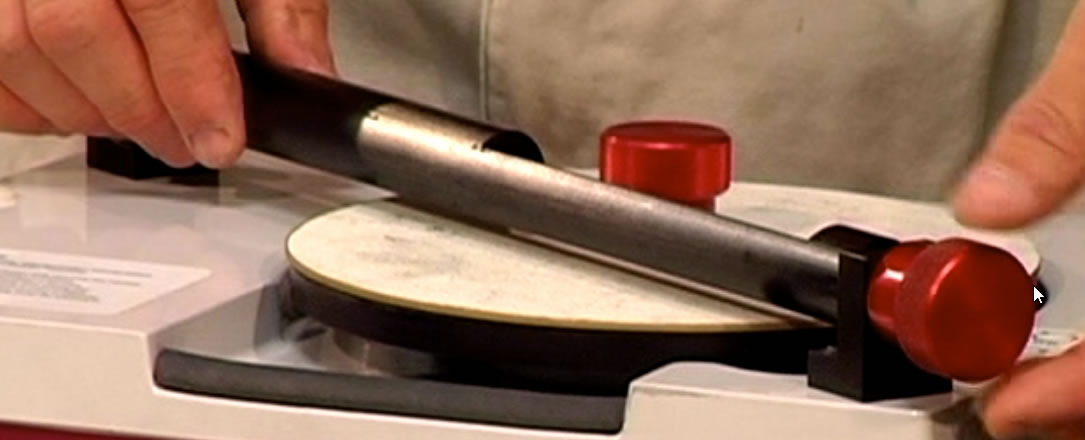
7:10 clamp holding plane iron chisel rides on outside of tool bar round stock, so it appears the face of the plane iron rides on the flat face of the tool bar
7:30 can change grits without relocating tool bar
8:08 abrasives
8:24 120 micron grit, 80, 40, 20, 10
are included
coarser of those grits are aluminum oxide micro finishing film
film backing is very flat, can't use cloth back as it would tend to round off bottom of blade as cloth compresses with pressure
very high grit consistency won't show scratches the way wet dry sandpaper would as that has only ~50%
git consistency
10 micron is trizac
10:32 5m 3m 1m polish pack is normally only needed for very very hard steels such as those used in Japanese blades
11:10 applying abrasive to disc
remove backing, bow abrasive to pringles shape, apply at center towards edges, roll with roller towards outside
1157 sharpening process
1309 japanese plane blade start with 5 micron abrasive (peach colored, looks like trizac)
japanese blades have large enough bevel to hold without jig, probably can't do with Stanley type blades
spray bottle water with a couple drops of detergent
back side has previously been flattened
he did it freehand beacause he claims there is large enough surface
1431 3 micron pink then 1 micron white
1457 thick cast steel plane blade
LAPPING PLANE IRON BACK
1525 tool bar and flatten stanley type blade
1640 he started with 80 micron because there was pitting
lubricated it with spray bottle
1711 can leave toolbar in place but he removed it so viewers could better see
the first touch was only maybe 1 second then more on same grit moving side to side to distribute wear
he did following grits on same location of disc, so how does he see new scratch pattern?
1808 40 micron
20 micron
10 micron was blue looked like trizac
I am surpised they stoppped at 10 micron???
sharpening bevel
1900 went back to "coarse abrasive" 120 grit and put on toolbar
typical bevel is 25 degrees with 30 degree microbevel (which lap-sharp can do) but he just went with 30 degree primary and no secondary
1950 using smaller clamp register blade edge to one side
2020 put guage on abrasive and use it to hold blade at proper angle then lock tool guide bar knob
"at this point i want the clamp to ge against the tool guide bar and then i will tighten the clamp."
120 micron
80 micron
40 micron
20 micron
10 micron again looked like blue trizac
22:18 may need to re-adjust the chisel position in the holder as metal is ground away but the angle will be maintained by guide bar
22:45 optional grits
5 micron
3 micron
1 micron is put on and he removes the bur on the 1 micron before honing the bevel
23:40ish i think he mentions chisels - probably says to do it the same way
23:50 wedge shaped blades
if the plane iron is wedge shaped [in elevation view] thicker at business end and tapering thinner near lateral adjuster
be sure to measure/set the bevel from the back of the blade (that is facing up) and the abrasive
rather than the abrasive and the toolbar then putting the blade on it
2435 jigs
planer jig first i didn't take notes but should if i buy it
he uses regal abrasive
2825 carving tools and knives
[non-woodcarving] knife at ~28:30
fairly dull so he started at 80micron
then 40micron, 20micron and he stopped there.
3158 use it to lap the outsides of mortise chisel
3207 can be used as a detail sander
3300 oil content in many tropical hardwoods gums up sandpaper quickly
sandpaper can be washed off with a brush & soap & water "going at right angles", he apparently described it earlier
34:20 washed disc vs unwashed
end at 3546
Sharpening Techniques menu item x
0:00 if plane iron is too wide follow described techniques
0:50
if plane iron is too wide follow described technique second option using chisel's chip breaker rotated 90 degrees
1:15 making wood block for each chisel
to prevent wiggle of chisel while sharpening
2:18 don't slide chisel, move while wheel stopped results in more even wear of wheel abrasive
2:52 don't move to the next grit too quickly
3:40 at 10 micron and below, be careful of contamination from coarser grits, wipe down tool throughly after each grit
4:30 when lapping chisel back, keep chisel in line with rotation (parallel to wheel tangent) rather than across rotation (radius) so edge doesn't tear polishing papers
5:08 keep chisel in motion so no groove/gouge where edge of wheel is
5:37 Japanese hand made tools might not be perfectly square; if not even scratch patterns across bevel, make sure to square it using technique he describes at 6:15
6:28 he claims tools with a large bevel such as a plane iron don't require a honing jig. seems silly to me
6:58 don't start with tool on wheel edge as motor start will jerk tool away from you, start pointed towards center then sweep so pointed close to tangentially
videos
this page https://web.archive.org/web/20100308030024/https://www.woodartistry.com/company/woodworking-videos.html had flash videos that pointed to youtube videos so I just copied the page source and searched for youtube
Lap-Sharp Plane Iron Flattening
start 120 micron
80 micron only about
3 or 4 seconds on each grit
35 micron
10 micron
Lap-Sharp Woodworking Sharpening System for Plane Iron Flattening (Part #2)
5 micron maybe 6 seconds on this grit
3 micron - he doesn't use lubricant on this one
1 micron - light pressure no lubricant - he mentioned 1 micron is about 12,000 grit
Lap-Sharp Wet Sharpening Woodworking System for Card Scrapers
http://www.youtube.com/v/4NX-b371cZ4
http://www.youtube.com/v/VzAYZ92z5C4
ttp://www.youtube.com/v/nBk91-dBcoQ
should check different dates of the page such as this one
https://web.archive.org/web/20190621031648/http://www.woodartistry.com/company/woodworking-videos.html
http://www.youtube.com/v/vB_FbjIBR1g
http://www.youtube.com/v/S99Sf0uGbL0
http://www.youtube.com/v/DX8zlHt7BoI
http://www.youtube.com/v/4NX-b371cZ4
http://www.youtube.com/v/VzAYZ92z5C4
http://www.youtube.com/v/nBk91-dBcoQ
8" psa lapping film discs but in qty 100 metallographic.com and diamond grits in qty 5 packs
precisionfiberproducts sells packs to, unclear how many for $66.55
rectangular sheets for $7 each down to 0.3 micron
https://www.bestsharpeningstones.com/article_details.php?id=13&article_name=How%20to%20Use%20Lapping%20Film%20for%20Sharpening
https://support.wickededgeusa.com/portal/en/kb/articles/lapping-films-what-they-are-and-how-to-use-them#What_is_Lapping_Film
https://support.wickededgeusa.com/portal/en/kb/articles/how-to-achieve-a#Benefits_of_a_Mirror-Edge
trizact
https://www.3m.com/3M/en_US/metalworking-us/products/featured-products/trizact/
https://multimedia.3m.com/mws/media/707137O/3mtm-plating-and-polishing-finishing-system-brochure.pdf
FWW 198 p16 using drip irigation tubing for pre-defined drip rates

reviews
wood magazine review see bottom entry
American Woodworker January, 2006.pdf pdfp 30 good review, claims it is newly on the market for $600, optional tool guide bar is $80
laping film
Prices of lap-sharp sanding discs from 2013
replacement 3M Aluminum Oxide films at Lee Valley
maverickabrasives.com may sell them too
table info taken from Abrasives Applications4.pdf:
| |
microns / grit |
use |
qty he ordered |
notes |
| Regalite 777F |
36 mesh grit maybe 400 microns |
Normally used dry
planer jointer knives - coarser abrasive to provide "damage repair" of knives
per 3M 777F Ceramic Abrasive Grain and aluminum oxide cuts faster and lasts longer than traditional aluminum oxide |
4 |
|
| Regalite 777F |
50 mesh grit maybe 250 microns |
Normally used dry
planer jointer knives - coarser abrasive to provide "damage repair" of knives
per 3M 777F Ceramic aluminum oxide grain blend cuts faster and lasts longer than traditional aluminum oxide |
10 |
|
| Aluminum Oxide Microfinishing film |
180μ |
Turning and Carving Tools coarse grits that were special order
Water and detergent to lubricate |
10 |
|
| Aluminum Oxide Microfinishing film |
150μ |
Turning and Carving Tools coarse grits that were special order
Water and detergent to lubricate |
10 |
|
| Regalite 777F |
80 mesh grit maybe 145 microns |
Normally used dry
planer jointer knives - coarser abrasive to provide "damage repair" of knives
per 3M 777F Ceramic aluminum oxide grain blend cuts faster and lasts longer than traditional aluminum oxide |
10 |
|
| Regal 972L |
120 micron |
planer jointer knives - finer finishing than is used commercially;
also shaping turning and carving tools
coarse abrading of steel tools
|
|
included with machine |
| Aluminum Oxide Microfinishing film |
120μ |
Turning and Carving Tools coarse grits that were special order
Water and detergent to lubricate |
10 |
|
| Regalite 777F |
120 mesh grit maybe 102 microns |
Normally used dry
planer jointer knives - coarser abrasive to provide "damage repair" of knives
per 3M 777F Ceramic aluminum oxide grain blend cuts faster and lasts longer than traditional aluminum oxide |
10 |
|
| Regal 972L |
80 micron |
planer jointer knives - finer finishing than is used commercially;
also shaping turning and carving tools
coarse abrading of steel tools
|
|
included with machine |
| Aluminum Oxide Microfinishing film |
80μ |
Turning and Carving Tools coarse grits that were special order
Water and detergent to lubricate |
10 |
|
| Aluminum Oxide Microfinishing film |
60μ |
Turning and Carving Tools coarse grits that were special order
Water and detergent to lubricate |
10 |
|
| Regal 972L |
60 micron |
planer jointer knives - finer finishing than is used commercially; also shaping turning and carving tools |
|
|
| Aluminum Oxide Microfinishing film |
40 micron |
Turning and Carving Tools better edge than grinder
Water and detergent to lubricate |
10 |
|
| Trizact |
A35 ~=P500 (Average grit size in microns 30) |
MUST BE USED WET;
fine finishing the backs and bevels of tools
planer jointer knives - finer finishing than is used commercially - beyond Regal 972L |
10 |
included with machine |
| Aluminum Oxide Microfinishing film |
20 micron |
Turning and Carving Tools better edge than grinder
Water and detergent to lubricate |
10 |
|
| Trizact |
A20 ~= P1000 (Average grit size in microns 18.3) |
MUST BE USED WET;excellent choice for sharpening plane irons and chisels;
use the surface evenly (turning tools may wear a track, so don't use Trizact for them)
long abrasive life and their apex structure keeps swarf in valleys |
10 |
|
| Trizact |
A10~=P1500 (Average grit size in microns 12.6) |
MUST BE USED WET;excellent choice for sharpening plane irons and chisels;
fine finishing the backs and bevels of tools
use the surface evenly (turning tools may wear a track, so don't use Trizact for them)
long abrasive life and their apex structure keeps swarf in valleys |
10 |
included with machine |
| Aluminum Oxide Microfinishing film |
9 micron |
require constant flushing
Turning and Carving Tools better edge than grinder
use WD-40 or Formula 409 as a lubricant and be able to wipe the swarf from the abrasive surface
|
10 |
|
| Trizact |
A5 ~= 3000 "conventional grit" No leading P => maybe average grit size apx 6 |
MUST BE USED WET;excellent choice for sharpening plane irons and chisels;
; very fine edge to hard steel tools such as A2 steel and laminated steel blades;fine edges on carving tools
use the surface evenly (turning tools may wear a track, so don't use Trizact for them)
long abrasive life and their apex structure keeps swarf in valleys |
10 |
polish pack |
| Aluminum Oxide |
3 micron |
require constant flushing
very fine edge to hard steel tools such as A2 steel and laminated steel blades;fine edges on carving tools; "polish paper" on order?
use WD-40 or Formula 409 as a lubricant and be able to wipe the swarf from the abrasive surface |
10 |
polish pack |
| Trizact |
3μ polish pack ~= 4000 "conventional grit" No leading P => maybe average grit size apx 3 |
|
9 |
|
| Aluminum Oxide |
1 micron |
require constant flushing
very fine edge to hard steel tools such as A2 steel and laminated steel blades;fine edges on carving tools; "polish paper" on order?
use WD-40 or Formula 409 as a lubricant and be able to wipe the swarf from the abrasive surface |
10 |
polish pack |
| Lapping Film |
1μ |
fine edges on carving tools; WD-40® can be used as a lubricant (to prevent the swarf from sticking to the abrasive surface) |
10 |
|
| |
|
|
|
|
| |
|
|
|
|
| |
|
|
|
|
| Diamond |
120 mesh grit |
for sharpening carbide tools; needs continuous lubricant drip system; "125μ" on order? |
6 |
|
| Diamond |
220 mesh grit |
for sharpening carbide tools; needs continuous lubricant drip system; "74μ" on order? |
6 |
|
| |
|
|
|
|
| Cubic Boron Nitride |
|
more expensive than diamond abrasives; used where durability of the abrasive is needed
high speed steel, die steel, hardened carbon steel, alloy steels, aerospace alloys, and abrasion-resistant ferrous metals |
|
|
see "Sharpening TipsV2.pdf" for this chart of grits:
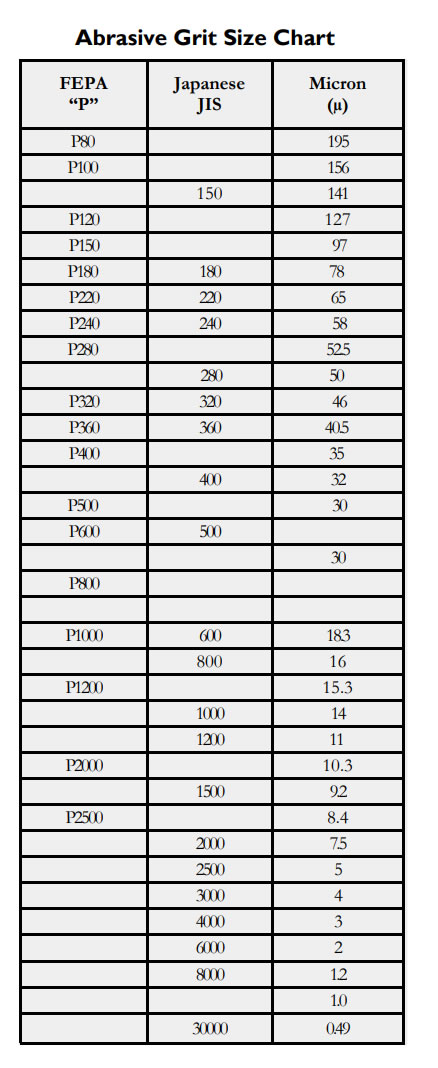
info from here
This lapping film is made in the USA by 3M (TM). These microfinishing lapping sheets were developed for industrial applications and can be used to flat lap or polish just about anything. This lapping film contains carefully graded aluminum oxide particles that are electrostatically coated onto a high strength polyester film backing. This fast cutting, water resistant abrasive provides precise, consistent, close tolerance finishes, and are available in a wide range of precise micron grades to meet any sharpening or polishing need. They can be affixed to a hard flat surface (usually 1/4 inch glass) and used to get a scary sharp edge on wood chisels or plane irons. They can be wrapped around contoured sticks and used to sharpen carving tools. They can put a wicked sharp edge on all kinds of knives. They can also be used to put a fine polish on jewelry or gem stones. These are PSA and have pressure sensitive backing. They have a 3 mil high-strength polyester film backing which is less likely to tear than traditional wet or dry sandpaper. The sheets are not marked so using their color is the only accurate way to identify them. These Aluminum Oxide (AO) sheets come in the following grades:
1) 0.3 micron (white) or 60.000 grit
2) 1 micron (light green) or 14,000 grit
3) 3 micron (pink) or 8,000 grit
4) 9 micron (light blue) or 1800 grit
5) 12 micron (yellow) or 1200 grit
6) 30 micron (green) or 600 grit and
7) 40 micron (blue) or 300 grit.
The sheets are not marked so using their color is the only accurate way to identify. In the finer grits, it can be difficult to differentiate the abrasive side from the backing. The abrasive side will always have a matte finish, where the film backing side will be glossy.
Sharpening Log
| plane |
date |
|
|
|
| No 4 bronze |
2024-03-14 |
35 degree (roller was at 12 o'clock postion so no add) for camber on 1000 and 8000 2023-03-13 730AM
25 primary 30 +1 or +2 secondary since roller was at 6 o'clock postion (no camber initially) 2024-03-10 1108AM
[moved info from google keep 2024-12-07] |
|
|
| |
|
|
|
|
| |
|
|
|
|
| |
|
|
|
|
| |
|
|
|
|
| |
|
|
|
|
| |
|
|
|
|
| |
|
|
|
|
| |
|
|
|
|
| |
|
|
|
|
| |
|
|
|
|
| |
|
|
|
|
| |
|
|
|
|
| |
|
|
|
|
| |
|
|
|
|
| |
|
|
|
|
| |
|
|
|
|
| |
|
|
|
|
| |
|
|
|
|
Sharpening Makita
Randy Richard video actually using it and making adjustments
Ask Woodman video series (8 parts) on use
2010 he bought a replacement unit
2016 he created his own hand held jig that holds both knives at one time
sharpening drill bits
The WoodLife restoring one and using it he made a jig for his diamond dresser, but since a water stone instead of a grinding stone, the Norton dressing stone (or even sandpaper on a block of wood I imagine) could be used.
sawmillcreek thread on 'truing' - really removing glaze on the coarse wheel - use either diamond plate or diamond dresser 1"ish bar with handle - same as in the video; 1 guy uses nagura
video by a guy showing setup but not actual sharpening
Hitachi Hikoki version video of guy sharpening knives but he doesn't use jig and seems to be filming the first time he uses it (plus he needs giant tranformer to use it)
American Woodworker general review of types of grinders selects Makita to buy (but maybe wait for the soon to be released Tormek)
Think about buying a Tormek
DO NOT GET this grizzly Tormek knock-off 220 grit wheel sounds wrong with good number of accessories
Sharpening Misc
sticky: Rich Colvin's website Sharpening Handbook contains all kinds of sharpening information and angles for specific types of tools (e.g. a particular type of hoe or axe or plain iron), mostly with a lean towards using a Tormek
Rob Cosman: Sharpening A Plane Blade 2020 38 minute video
fww 0258 pdfp15 cookie sheet under shelf storage of stones
PWW Oct 2011 p24
for finer grits when sharpening on sandpaper the paper tears easily
mylar backed abrasives are somewhat better than normal sandpaper, and adhesived backed films are better yet
2025-01 fww 2014-09 pdfp37 sharpening with diamond plates and diamont paste
2025-01 facebook post listing sharpening services
2024-10 17 tips for sharpening from pww
2023-05 super detailed ~65 page .pdf on sharpening that to date I have only read portions of. (local .pdf)
2024-10-06 pww recommended book A Sharpening Handbook: What Every Woodworker Needs to Know About Sharpening by Richard D. Wile
unicorn sharpening and PWW article about it
detailed online book on using a tormek grinder
brochure showing attachments and jigs (local .pdf)
Lie-Nielsen youtube videos sharpening playlist
Lie-Nielsen Tool Care don't store planes in the socks
other Matt Estlea sharpening videos
sharpening DVDs I should check out FWW 0188 pdfp122
adhesive backed sheets (or close in size to full sheets) that could be attached to low tach tape on granite surface plate to flatten water stones
2.95 each for 120 grit at Klingspor
fww 224 46 sharpen jointed knives in place
Odd & Irregular shapes
PWW June 2005.pdf For odd shapes author holds them in handscrew that he then puts in vise then uses sanding fids - curved scraps of wood with adhesive backed sandpaper attached to them
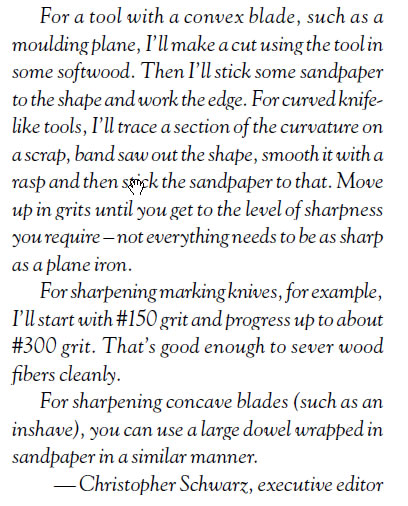
FWW 0305 pdfp26 "How to sharpen odd shaped tools" Chris Schwarz on router plane blades, scorps, travishers, curved card scrapers, moulding planes
Sharpening - Oil to apply afterwards
Camellia oil works best according to sailing ship woodworker but not compared to jojoba FWW 0221 pdfp81
Sharpening Plane Irons
fww How much camber should be in plane irons? (local .pdf)
Hand Tool Techniques Part 1 Plane Sharpening with David Charlesworth including link to printed article describing same technique
The Ruler Trick PWW 2004-11 pdfp61
more info on ruler trick 4 blog posts from rpwoodwork that details the "wear bevel" (good favorite finishes posts from same guy)
detailed rpwoodwork.comblog posts on ruler trick on archive.org
One behch Plane can do it all FWW 217
Sharpening a Toothed Blade FWW 02119 pdfp 12 - question on what to do when teeth sharpened away. answer is teeth extend 3/4" up the blade so it will last many years
Lie-Nielsen silent video on honing a new blade
Lie-Nielsen youtube videos sharpening playlist
Deneb Puchalski videos
Sharpening plane Irons Part 1: Honing the Micro Bevel with Deneb Puchalski -
don't use ruler trick on chisels
1:02 1000 grit and 8000 grit water stones
1:16 flatten stones with 120-220 grit wet dry sandpaper
or a coarse diamond plate
1:25 6" ruler .020" or less in thickness
to make back bevel
2:16 ruler trick 8000 grit stone, don't come more than 1/2" onto stone 10-20 passes on and off edge
don't use ruler trick on chisels
4:00 blade comes with 25 degree primary bevel
4:19 several secondary bevels may be used, most common is 30 degrees
5:20 using a protractor to determine blade projection
but never get exactly the same
6:54 secondary bevel make 4 pull passes with even finger pressure on corners on 100 grit
should give burr (wire edge) all the way across, then clean wheel and blade
7:38
4-5 passes on 8000 grit
8:05 ruler trick (not on chisels!) on 8000 grit 4 passes to remove wire edge wipe down with jojoba oil redress stones
Sharpening plane Irons Part 2: Flattening [water] stones with Deneb Puchalski
0:10 use 120 or 220 wet dry paper on surface plate
0:33 break back of paper so it cups down and lays flat by running on edge of surface plate
0:40 spray both sides of paper, draw grid on stone
1:45 alternately use coarse diamond lapping plate to water stone; need to flush diamond stone after so swarf doesn't harden;
3:15 chisels in lower jaw of eclipse style honing guide 25 degree stop becomes 30 degrees
3:50 regrind primary bevel with 80-150 grit sandpaper; mark entire bevel with sharpie
4:40 on coarse sandpaper paper [or 400 grit diamond stone], leave a bit of polished edge when re-establishing
primary bevel to maintain the integrity of the blade
Lie Nielsen Quick Tips Episode 4:
Re-Establishing the Primary Bevel with Deneb Puchalski youtube video
>340F begins to draw temper out while color won't change to 600F or 700F
Matt Estlea plane iron
sharpenig video 2022 youtube older one
Sharpening cloverleaf plane spurs [Popular Woodworking 2006 August] pdfp11
Scrub Plane / Heavy Camber
Sharpening the No 40 1/2 Scrub Plane video (or Roughing Blade with large camber for my No 4 & No 5)
Sharpening Saws
PWW 2004-08 pdfp 75 listing of companies that will sharpen hand saws
Sharpening Scissors
scissors sharpening thread (archived) on Sawmillcreek that turned me on teo the AccuSharp
Sharpening Scrapers and Scraper Planes
arno burnisher on sawmillcreek
FWW 0305 pdfp26 Chris Schwarz on sharpening curved card scrapers et al.
see "8. Scraper Sharpening" in Lap-Sharp doc "Abrasives Applications.pdf"
comparison of 14 methods of sharpening scrapers and merged technique "Popular Woodworking Feb 2007" pdfp.25
Lie-Nielsen video "Scraping Planes Part 2: Sharpening and Care youtube"
Card scraper sharpening video at woodworkingmasterclasses.com
| |
|
DATE |
ISSUE |
PDFP |
P |
| sharpening scrapers |
popular woodworking |
feb 2007 |
|
25 |
40 |
| Sharpening a curved scaper FWW 0192 pdfp86 |
fww |
|
0192 |
86 |
|
| The right way to sharpen your scraper |
fww |
|
227 |
22 |
|
Sharpening - Strops
PWW article on making a simple strop from leatther and mdf. the author hones to 8000 grit before stropping.
Sharpening - Testing for Sharpness
ShopNotes 028 p15 - pare off a softwood end grain corner
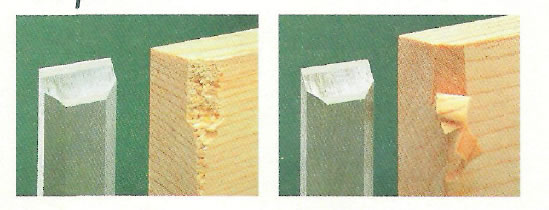
3 ways to determine if a chisel is sharp from PWW issue not recorded
 s
s
Services
Freud listed peaktoolworks.com in Tallmadge as the closest sharpening service for their blades
when I contacted them in 2024-09 I was told they have a $150 minimum order
Sharpening - Tool Steels Compared
FWW 0230 pdfp16 new PM-V11 tool steel review
tool steels compared video by Matt Estlea:
O1 softer metal that takes the keenest edge; dulls kinda easy and rounds over and won't cut at all when dull; he likes for shoulder planes so you are forced to sharpen and can always cut end grain nicely since it takes the keenest edge
A2 harder can't get as sharp as O1 doesn't round over when dull so can still use it thus less frequent sharpening; he likes for his No 4 since he sands afterwards and doesn't always need the keenest edge; he
much prefers A2 chisels over O1 chisels since there is mallet impact and A2 stands up to it much better
PM-V11 premium priced, has best features of the other 2 combined; he likes for pretty much anything other than shoulder planes
so I guess I should buy A2 chisels and future shoulder planes I should buy Veritas with O1 as in his other video comparing Lie-Nielsen vs Veritas shoulder planes he much prefers that the Veritas shoulder planes can be used on the side much more comfortably when the shoulder being cut is on a board resting horizontally. For the Lie-Nielsen shoulder planes, if the board is vertically mounted the handle is more comfortable and allows more downforce but there is no comfortable way to hold it sideways.
Sharpening - Turning Tools
PWW Sharpening turning tools
2023-12-19 home made woverine style grinding jig video local .pdf of plans
Sharpening gouges - the 40 degree solution 0187 pdfp100
fww 266 p14 sharpening gouges with sandpaper, tape and dremel rotary tool
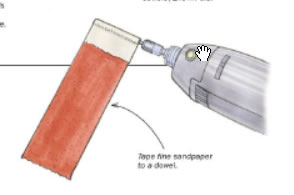
Tormek attachments
see "tormek accessories brochure.pdf"
sticky: Rich Colvin's website Sharpening Handbook contains all kinds of sharpening information and angles for specific types of tools (e.g. a particular type of hoe or axe or plain iron), mostly with a lean towards using a Tormek
I have
- Tormek KJ-45 Centering Knife Jig [MB for birthday 2024]
- Tormek SVA-170 Axe Jig
- Tormek BGM-100 Bench Grinder Mounting Set [MB for Christmas 2024]
- Tormek SVM-140 Tormek Long Knife Jig
- I bought 2025-01-23 on clearance at Woodcraft 66 down to 46.20
- this Highland page indicates it is no longer available.
- There are two knife jigs, for short or long knives, which cleverly allow you to sharpen both sides of a knife to exactly the same angle without resetting the jig. Their design lets you stroke along the curved tip of a blade as easily as along its straight length. The Long Knife Jig is for chef's knives or any blades from 4-3/4" to 11" long.
It handles portable electric planer blades, too.
- Fits Tormek Supergrind or Tormek T 7 Sharpening System.
- This jig replaces the SVM-100. It has a wider clamp to stabilize long, flexible knives.
- I did not buy the SVM-100 that it replaced
- I also did not buy the KJ-140 which appears to have replaced the SVM-100
Consider buying:
- AX-40 Axe Jig
- SVM-00 Small Knife Holder
- shows carving knife being held by handle in pic
- Tormek SVX-150 Scissor Jig
- Tormek SVD-110 Tool Rest
- flat plate like veritas grinder rest
- Tormek XB-100 Horizontal Tool Rest Base
- probably don't need for reversible lap-sharp
- "lets you mount the rest at the rear of the machine for grinding away from the cutting edge, ideal for carving and turning tools."
- Tormek SVS-38 Short Tool Jig
- sharpen short chisels and carving tools, especially bits for reciprocating power carvers
- maybe KJ-140 Wide Centering Knife Jig
- (The KJ-140 Wide Centering Knife Jig cannot be used with the SVM-00 Small Knife Holder. Use the KJ-45 Centering Knife Jig instead.
my old note read "
incompat with SVM-100")
- for long, flexible blades such as fillet knives
- The KJ-140 Wide Centering Knife Jig works in the same way as the KJ-45 Centering Knife Jig but has a wider clamp
- The wider 140 mm (5 1/2") clamp stabilizes thin and flexible knife blades and provides more support for an even bevel along the entire blade.
- Of course it can also be used with larger knives with more stable blades, such as chef's knives.
- Because the KJ-140 Wide Centering Knife Jig is positioned with the stop resting freely against the universal support, you are able to follow the shapes of the knife, always guided by the universal support as a reference point. This makes it possible to sharpen knives with different blade shapes, from fillet knives to recurve knives and classic chef's knives.
- the KJ-140 Jig holds knives 160mm (6-1/4" and longer. The blade must be at least 12mm (1/2") wide. Maximum thickness is 10mm (3/8") for standard blades and 6mm (1/4") fro fully tapered blades.
Tormek BGM-100 Bench Grinding Mounting Set | burnstools.com
2025-01-29 links
thoughts on Tormek SVM and KJ knife jigs
- enthusiast ken s started with one SVM-45 and one SVM-140
- he also likes extension US-1430
- The new KJ 45 jig is really good for centering most everyday knives be they thin or thick on the blade stock. But it is really compromised for its lack of adjustment on the jig protrusion.
- The old svm jigs were great for adjusting jig protrusion and no good for centring thin or thick knife
kenjig for setup mentioned in this post can be found here (local .pdf)
revisiting the kenjig
chart for kenjig dimensions
Sharpening for a better burr
Why either / or for SVM vs KJ
thoughts on SVM and KJ knife jigs
Knife Point Setting Template
A Faster, More Repeatable Way to Set Up Tormek Universal Support Bar Height
Waterstones
2024-02-23 It appears that 120 grit diamond stone would be decent for flattening 1000 grit water stone
400 git would be decent for flattening 4000 grit water stone and finer
| source |
grit |
instructions |
| PWW |
<4000 = non-finishing |
soak at least 10 mins before use
OK to store in water |
| Woodcraft |
250-400 = coarse |
soak 20-30 mins before use
OK to store in water |
| Woodcraft |
800-1200 maybe 2000 = medium |
soak 20-30 mins before use
OK to store in water |
| Woodcraft |
4000-8000= finishing |
|
| Shapton |
12000 |
translation:
soak 2-3 mins before use
DO NOT store in water |
| Charlesworth's Chisel sharpening video |
Norton 1000 = coarse |
|
| Charlesworth's Chisel sharpening video |
Norton 4000 = medium / fine |
not used in plane iron shapening (chisels only) |
| Charlesworth's Chisel sharpening video |
Norton 8000 = super fine |
|
| Charlesworth's Chisel sharpening video |
King 800 = coarse |
|
| Charlesworth's Chisel sharpening video |
King 1200 = medium / fine |
not used in plane iron shapening (chisels only) |
| Charlesworth's Chisel sharpening video |
King 8000 = super fine |
|
Resurrecting Chisels PWW 2005-02 pdfp56 p74
waterstones: 4000 grit
and above are considered "finishing stones"; all non-finishing stones should be soaked for 10 minutes before use, it is OK to store them in water
Lie-Nielsen on Norton Flattening Stone:
Use 80 grit sandpaper on a reliably flat surface to dress the face of the Flattening Stone.
Wood magazine youtube video on flattening watterstones
Woodcraft waterstone care and use
coarse 250-400
medium 800 1000 1200 sometimes 2000 - pretty much only if blade is nicked [or re-establishing primary bevel]
finishing / polishing 4000 6000 8000
before each use soak coarse and medium in water for 20-30 minutes; can be left in water
soak finish too [Shapton says 5 mins or less I think] but don't store in water
use Nagura to form slurry on polishing stones
for new [plane irons? had "stones" written here but that doesn't make sense] start with 1200 then 2000 then remove burr on finish stone
Sharpening Wood Working Tools Using Norton Waterstones - 27 minute mfg video showing procedure similar to Charlesworth
Norton Combination Waterstones review PWW 2005-02 pdfp17
waterstone sharpening tray Shopnotes 120 pdfp28
bench hook for sharpening stones fww 0223 p94

last updated:
Wed 2025-05-28 4:40 AM











